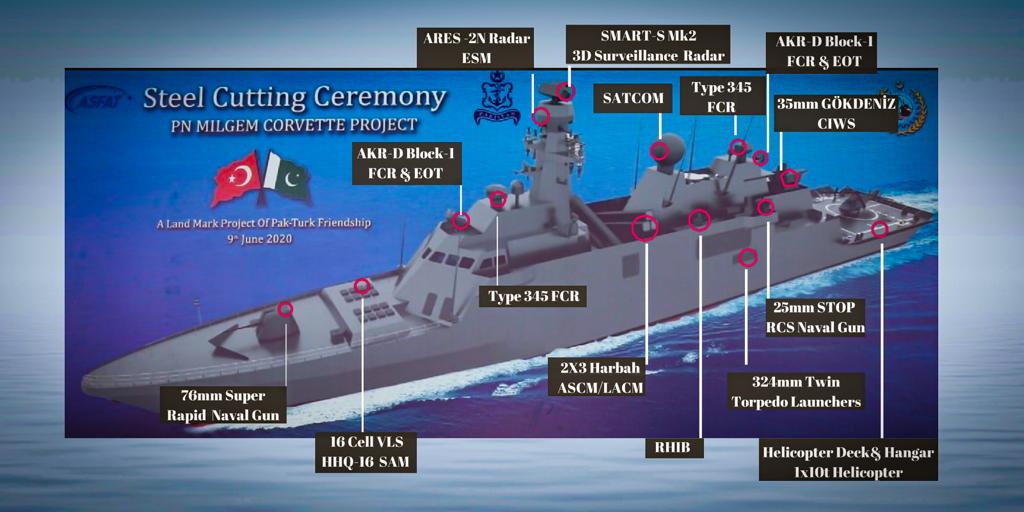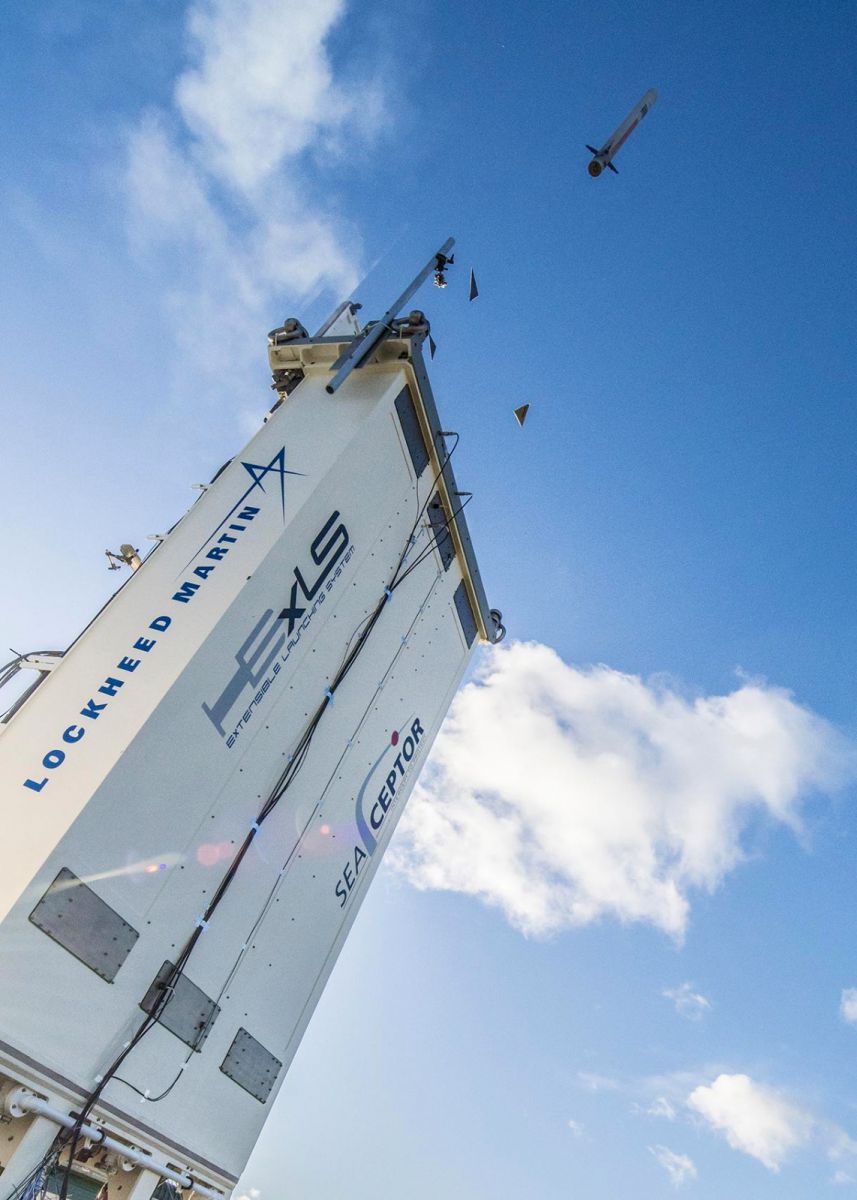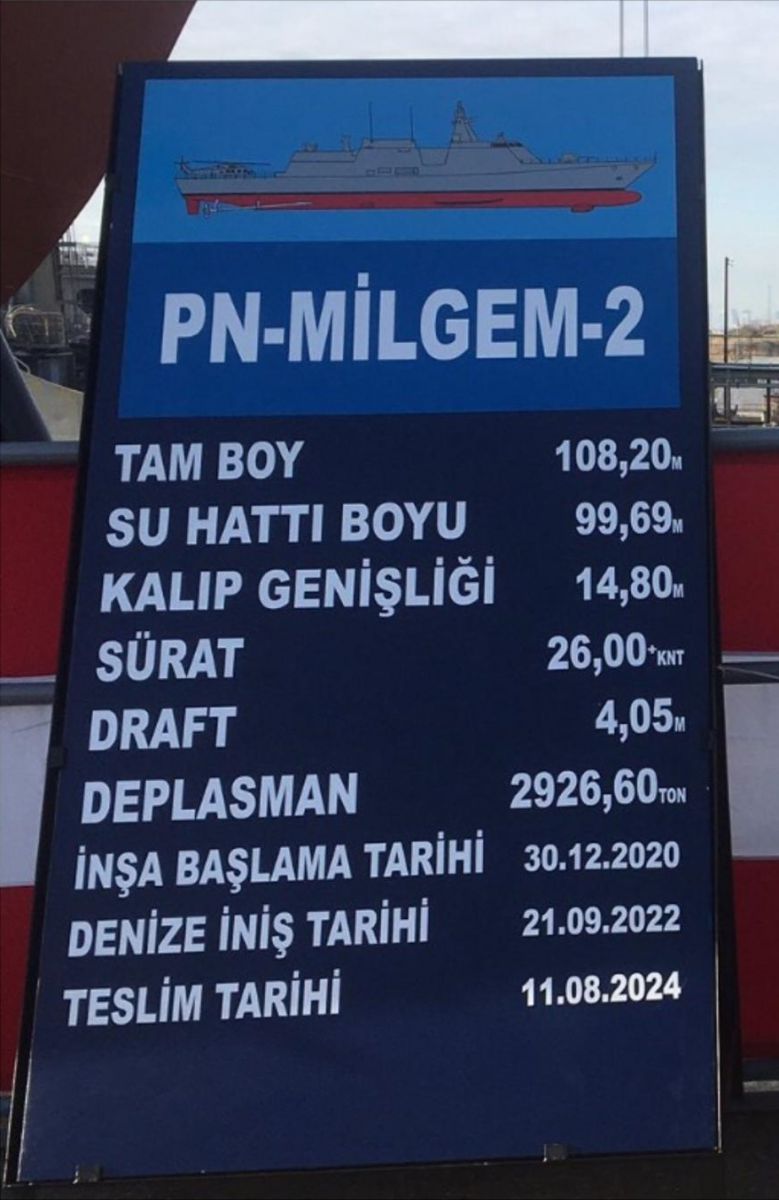Date: June 12, 2021
It has been decided to use the MBDA product new generation Naval Based Air Defence (NBAD) Albatros NG system instead of the HHQ-16 Medium-Range Air Defense Missile System in the corvettes to be built under the Pakistan Navy MİLGEM (PN MİLGEM) Project, the contract of which was signed between the Main Contractor ASFAT (Military Factory and Shipyard Management Inc.) and the Pakistan Ministry of Defense Production on July 5, 2018, in Islamabad and the construction activities (T0) of which was started on March 11, 2019.
According to the information I received, a number of improvements will also be made in the placement of the sensors on the ships as part of this last-minute change. As it will be remembered, on March 3, 2021, MBDA previously announced that it signed the first export contract with an undisclosed international customer for the Albatros NG NBAD System, which uses CAMM-ER (Extended Range) missiles. In the press release, it was stated that the Albatros NG System would become operational in 2024 within the scope of the order. With this acquisition, Pakistan Navy became the first customer/user of Albatros NG, and PN MİLGEM Corvettes became the first surface warship to use this new generation medium-range active guided air defense system. In addition, the Albatros NG NBAD System will be integrated into the GENESIS ADVENT CMS (Combat Management System) used on the ships.
.jpg)
Within the scope of the PN MİLGEM Project, which covers the construction of 4 corvettes based on the design of ADA Class Corvette in total, two of the ships will be built at the İstanbul Shipyard Command, and the other two at the Karachi Shipyard & Engineering Works (KSEW) in Pakistan. The construction of 3 corvettes is currently underway, and the first ship of the Project is planned to be launched in July 2021 and delivered in Turkey in August 2023 (Pakistan will accept the vessel here, then it will be taken to Pakistan). The construction of the 4th ship of the Project, which is expected to be delivered in Karachi in February 2025, is planned to start in June 2021 at the Karachi Shipyard & Engineering Works. It was previously announced that there would be some differences in the design of the fourth PN-MİLGEM Corvette. In this context, it was stated that Pakistani engineers and technicians who received on-the-job training during the construction of the first ship would be able to make changes on the ADA Class Corvette design up to the fourth ship. Thus, with the PN-MİLGEM Project, Pakistan will gain the ability to design and build its indigenous warship with the support of Turkish engineers. The new design ships that will be built as a continuation of the PN-MİLGEM Project are classified as JINNAH Class Frigates. The JINNAH Class Frigate concept, which is expected to be a joint design of Turkey and Pakistan, is expected to be introduced with the scale model to be exhibited at the IDEF '21 Fair held next August.
With a displacement of 2,926 tons, PN MİLGEM Corvettes sit between the 2,400-ton ADA Class Corvettes and the 3,000-ton İSTİF Class Frigates. When we look at the previously shared Computer-Generated Images (CGI) of the vessels, PN MİLGEM Corvettes have a 16-cell Vertical Launching System (VLS) for the HHQ-16 Medium-Range Air Defense Missile System just behind the Leonardo (Oto Melara) 76 mm Super Rapid main gun. China Aerospace Science and Technology Corp (CASC) product HHQ-16/LY-80N medium-range semi-active radar-guided air defense missile system is also used in Type 054A/P Frigates (with 32 cell VLS) currently under construction in China for the Pakistan Navy. With a maximum range of 42 km, the HHQ-16 has a 70 kg warhead and is claimed to have an interception altitude between 15 m and 18 km (the extended-range version of the missile, the HHQ-16B, has a range of 70 km). One of the Type 345 Target Illumination Radars (NATO code MR-90 Front Dome), which is part of the HHQ-16 Medium-Range Air Defense Missile System, was located just in front of the mast and the other just behind the funnel.

With the selection of the MBDA product Albatros NG System, a different 16-cell VLS will be placed behind the main gun for CAMM-ER/Albatros NG missiles. CAMM-ER/Albatros NG missiles have their own unique launch system (Soft Vertical Launch/SVL system, uses a cold gas generator to eject the missile from its canister), and can also be used in 'quad-pack' (4 missiles per cell) configuration in Sylver, ExLS, and Mk-41 Vertical Launching Systems. CAMM weighs 99 kg (218 lb), is 3.2 m (10 ft 6 in) in length, 166 mm (6.5 in) diameter, and has a range of 25 km. The CAMM-ER (extended range variant) shares the same characteristics as the original CAMM except for an additional rocket booster which significantly increases the engagement range to 45+ km and a slightly adapted missile structure. CAMM-ER weighs 160 kg (350 lb), is 4.2 m (14 ft) in length and 190 mm (7.5 in) in diameter. CAMM-ER has an active RF seeker and two-way data link, eliminating the need for a target illumination radar (the SMART-S Mk 2 3BAR data will suffice). Engagement information about the target (position, altitude, speed, etc.) can be transferred to the missile via the data link. Since there is no need for illumination radars, Type 345 (NATO code MR-90 Front Dome) Illumination Radars, which were previously located on the PN MİLGEM Corvettes for the HHQ-16 Medium Range Air Defense Missile System, will be removed, and two data link antennas will be installed on the ships. Thanks to the fire-and-forget CAMM-ER/Albatros NG NBAD System, PN MİLGEM Corvettes will be able to engage more air targets at the same time compared to the semi-active radar-guided HHQ-16 Medium-Range Air Defense Missile System and perform missions with higher performance in the EW threat environment.

The PN MİLGEM Class Corvettes will also be equipped with a total of 6 Harbah Anti-Ship & Land Attack Cruise Missiles (ASCM/LACM with an estimated range of 450 km to 750 km) or another missile system that is still under development (positioned at 90 degrees to each other, hidden behind the cover on the port and starboard sides behind the mainmast to reduce the RCS of the ship), two ASELSAN product 25 mm STOP Remote Controlled Stabilized Naval Guns (at the port and starboard deckhouses), and ASELSAN GÖKDENİZ Close-in Weapon System (CIWS).
The Main Propulsion System to be used in the PN MİLGEM Corvettes with a length of 108.2 m, a width of 14.8 m, and a draft of 4.05 m will consist of an LM2500 gas turbine and two 4000 Series MTU 20V4000M93L diesel engines that generate 4,300kW/5,766hp.
